Amazing facts about Plitvice Lakes National Park
The Plitvice Lakes National Park is considered one of the most beautiful national parks in Europe and the world. Although the water bodies of the National Park account for only 1% of its total area, they are its most attractive and most visited part. Here are some facts about the National Park that you might now know:
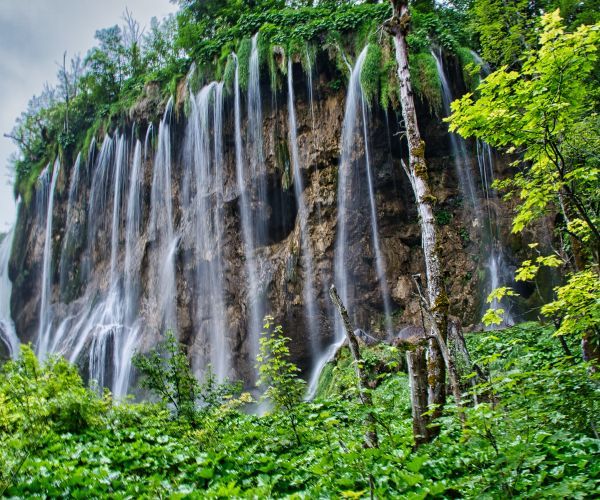
Tufa
Sixteen magnificent cascading lakes of various sizes were formed by a very complex biodynamic process of tufa barrier growth, which is one of the reasons why on 26 October 1979 the Plitvice Lakes were included in the UNESCO World Natural Heritage List and why they are considered to be of outstanding universal value. There are several definitions of tufa, one of them being: “Tufa is a hollow, porous rock formed through the deposition of dissolved calcium carbonate in water with the help of plants, algae and mosses”. An interesting fact is that tufa is present everywhere in the world, but nowhere else is there such a system, where tufa is deposited in a perfect and unique process, forming tufa waterfalls and cascades which connect all the lakes in the park.
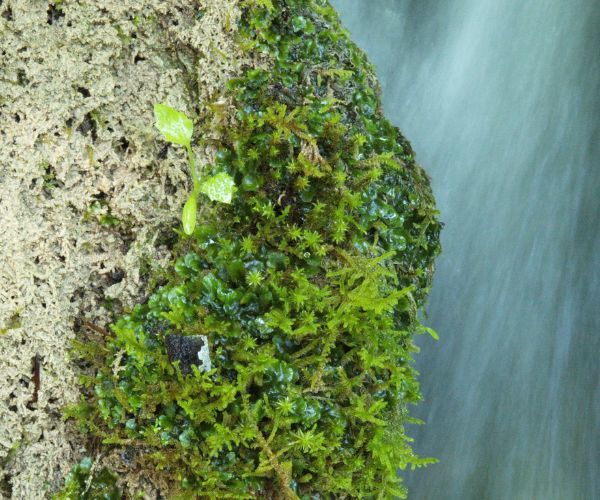
The process of tufa formation has not yet been thoroughly explored, but without a series of physicochemical and biological factors there would be no tufa, and without tufa, there would be no waterfalls or lakes, only a river. The process of tufa formation in the Plitvice Lakes dates way back into the geological past of the Quaternary Period. 250,000–300,000 years old barriers are found outside the present-day watercourses, which indicates how much the system has actually changed over the geological past. Tufa barriers are still active in today’s watercourses, constantly transforming the appearance of the lakes and waterfalls with their biodynamics. What is interesting about the largest lake Kozjak is that it was divided into two lakes approximately 400 years ago. Since the barriers in the lake do not grow at the same rate, the downstream barriers sometimes rise above the upstream ones, which then become submerged, causing the two lakes to merge into one. The submerged barrier in Kozjak Lake can be seen from the electric boat on a sunny day.
Changing water colors from blue to green
No matter how many times you walk along the paths of the Plitvice Lakes, you will admire the fascinating lakes, strung together like pearls, and their spectacular changing colors. The Plitvice Lakes exhibit an amazing spectrum of colors at any time of the day, never looking the same as the day before. The water exhibits an entire palette of shades, from emerald green to deep blue, turquoise or light gray. The colors vary from lake to lake, but also within individual lakes, to the delight of every visitor.
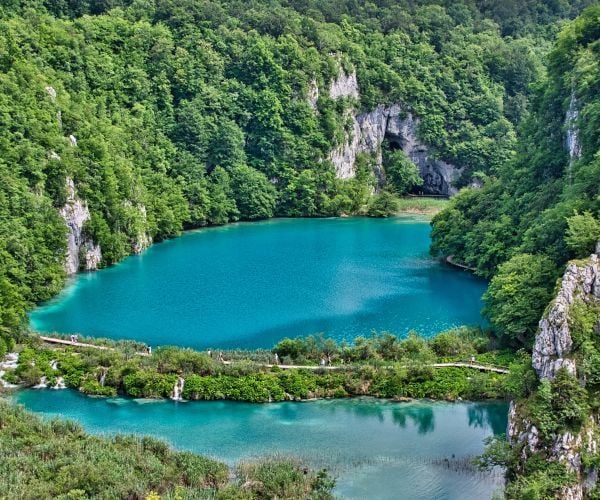
The arrangement of colors mostly depends on the concentration of dissolved organic matter, the concentration of various organisms in water, lake depth, the environment of the lake, weather conditions, the play of light and shadows and the surface water movement. Walking along the wooden paths around the Upper Lakes, which are enveloped by the forest, you will be enthralled by their emerald-green color. If you take a walk through the canyon of the Lower Lakes, you will enjoy an enchanting view of surreal turquoise and deep blue shades. This forested area certainly keeps the secret of those 16 lakes, and the sound of the magnificent waterfalls will not leave anyone indifferent!
The National Park bears
The Plitvice Lakes National Park has a recognizable logo depicting a bear, which represents this region of Lika. The species residing in the National Park is the largest European animal – the brown bear. This species typically lives alone, but also accepts the presence of other bears in the same area. Three-quarters of the Park is covered with forest. The beech and fir forests provide shelter and peace for bears, which take refuge and find food in these areas. They often communicate by scratching against a tree. In this way, they leave behind their scent and hairs, which other bears can easily recognize since they have a strong sense of smell.
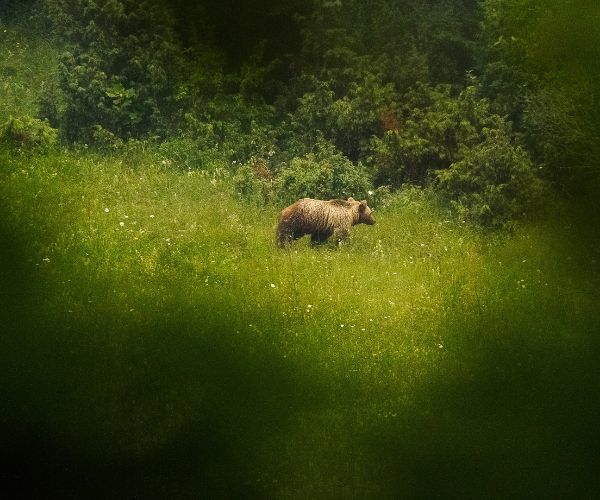
The National Park camera often captures bear cubs while playing. Followers on social media are always amazed by these videos. Since bears prefer to spend time in places without many people, and their diet is mostly plant-based, you don’t have to be afraid of running into a bear in the park. They find the forested area of the Park and the meadows where they can graze without worry way more interesting. There are not many garbage cans in the Park, because animals that come to search for food at night could access discarded scraps and snack on something that is not on their usual menu.
The Great Waterfall
For many people, the Great Waterfall is the first thing that comes to their mind at the mention of the Plitvice Lakes. What is interesting about it is that it is formed by the collapse of the Plitvice stream, the source of which is 3 kilometers away and does not belong to any of the 16 lakes. Together with the Sastavci waterfalls, this Great Waterfall is the source of the Korana river. The very appearance of the waterfall changes throughout the seasons. You can fully enjoy its magnificence in autumn and spring.
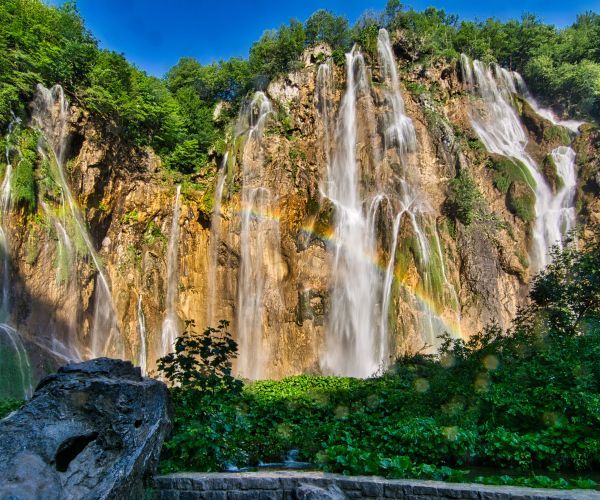
In the cold, winter months, temperatures sometimes drop so low that the waterfall freezes, which makes for an unforgettable sight. You will experience a special pleasure as the water from the Plitvice stream falls from a height of 62 m, creating water dust that provides refreshment during hot days. The total height of the Great Waterfall, which ends in the Korana River, is 87 m. This makes it the highest waterfall in the Park and in Croatia. In the period from 1968 to 1990, the National Park was used as a venue for weddings. The first Plitvice wedding took place right under the Great Waterfall. If you want a perfect setting for your special day, tie the knot under the Great Waterfall!
IMPORTANT NOTICE:
If you are reading this article anywhere other than on A Luxury Travel Blog, then the chances are that this content has been stolen without permission.
Please make a note of the web address above and contact A Luxury Travel Blog to advise them of this issue.
Thank you for your help in combatting content theft.
Virgin forest Čorkova Uvala
There is something completely magical in the peace of the forest, in its scents and trees that hide centuries-old stories. The same is true of the Plitvice virgin forest Čorkova Uvala (Čorkova Bay). Virgin forests are indeed special because, unlike most forests, they have never been logged. It is a misconception that virgin forests are completely isolated from human influence because that would be impossible. Climate changes, changes in the water regime, and tourist sightseeing are just some of the human activities that affect both the environment and the virgin forest. Forests occupy three-quarters of the Park and are not managed, but are left to develop naturally, which contributes to the preservation of numerous plant and animal species. These luscious forests teem with life. The virgin forest Čorkova uvala is home to the oldest measured tree in the Park, a beech more than 500 years old. Specimens of trees this old are common in the virgin forest, where very tall and thick fir, beech and spruce trees can also be found.
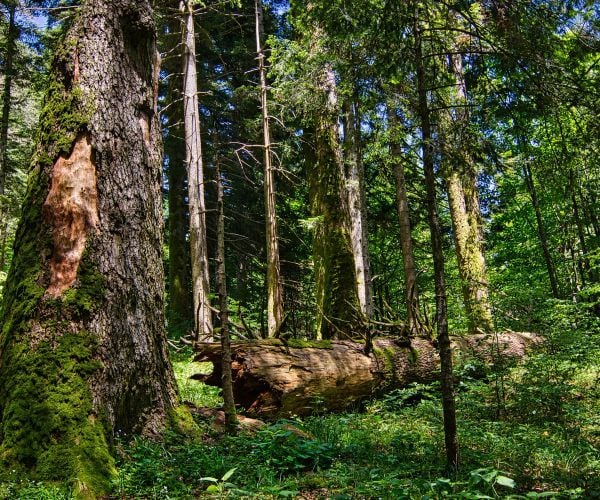
In Čorkova uvala, one can witness the undisturbed life process of all parts of the virgin forest ecosystem, the stages of ageing, decomposition and rejuvenation. Čorkova uvala has a basin structure and precisely because the trees are protected from the wind, they live longer and stand upright. This virgin forest can be visited as part of the National Park tour. It can be reached by a hiking trail, which will provide you with an excellent and authentic experience in the Park. Educational hiking trails aim to show visitors the ecosystem of the forest and its beauty. Visitors who want to better feel the pulse of nature, gain more insight into the role of the forest in the preservation of the lakes and enrich their knowledge about forests as part of an active vacation will certainly be impressed by the 21-kilometer trails with several educational boards placed along the way. In addition to being educational, this trail is also recreational due to the configuration of the terrain, which includes both climbs and tame meadows.
The legend of the Black Queen
How were the Plitvice Lakes formed? What set of circumstances causes the water to be rich in scale and flow through a limestone canyon and how come tufa is deposited so quickly due to microorganisms in the water? These are scientific questions, that numerous researchers are still seeking to answer. As with every place, legends and stories are told about this one as well. The Plitvice Lakes consist of 16 lakes interconnected by waterfalls. Each of them is the subject of a certain legend.
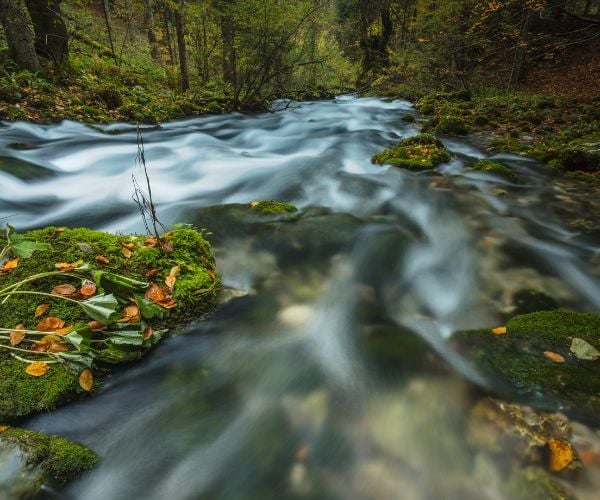
The legend about the origin of the Plitvice Lakes goes like this: In times of great drought, when the whole region was affected by a shortage of water, plants, animals and people prayed for rain. The meadows and gardens were dry, the land was barren, and everyone was begging for water. The Black River, the source of the Plitvice Lakes, had also run dry. One day, the Black Queen addressed the people from the heavenly heights: “Gather at dawn at the Spring of Life where you quenched your thirst and nourished your life. In that place, reveal everything that lies hidden in your souls. Speak with dignity, guide your words with heart and truth. Should you do so, I will stand by you.”) The people prayed for days, confessed their sins, repented for them, and the Black Queen decided to answer their prayers and promised them water in abundance. Once it started, it kept raining for days, until the water level rose so much that beautiful lakes were formed. The first lake of the Upper Lakes, Prošćansko, got its name from the word prositi (to beg) since the people obtained it by praying. The legend of the Black Queen in the golden carriage, her golden fairy hair and the fairies accompanying her has been retold for a long time and is still passed down to this day.
Tomislav Kovačević is General Manager at Plitvice Lakes National Park. Plitvice Lakes National Park is the oldest and biggest national park in Croatia.
If you would like to be a guest blogger on A Luxury Travel Blog in order to raise your profile, please contact us.
Did you enjoy this article?
Receive similar content direct to your inbox.



This place is just super! We were there on vacation with my wife in 2018, the beauty is breathtaking. We will definitely come back.
Dear Dymitr, we are glad to hear that and looking forward welcoming you at Plitvice Lakes National Park.
Regards from Plitvice Lakes National Park!
Once you start collecting facts and figures on anything you always come up with some fascinating stats. All of this helps build the picture on Plitvice.
Dear Caroline,
we are glad that you find the facts from the articles interesting and useful.
We are looking forward to your visit at Plitvice Lakes National Park.
Kind regards!
Hard to believe that the Plitvice waterfall has nothing to do with any of the lakes. What are the odds of that happening when you’ve got 16 lakes around?
Dear Ed, yes it’s amazing how it all came together in the end. We hope that you will visit us and see it for yourself. Best regards from Plitvice Lakes National Park!